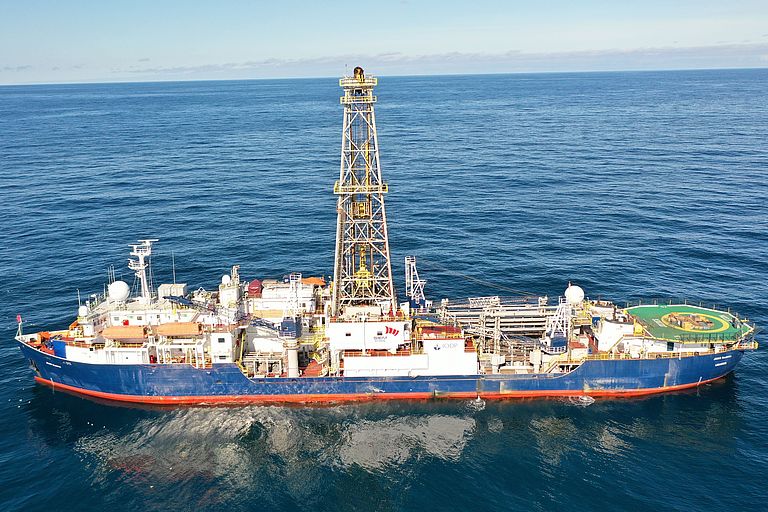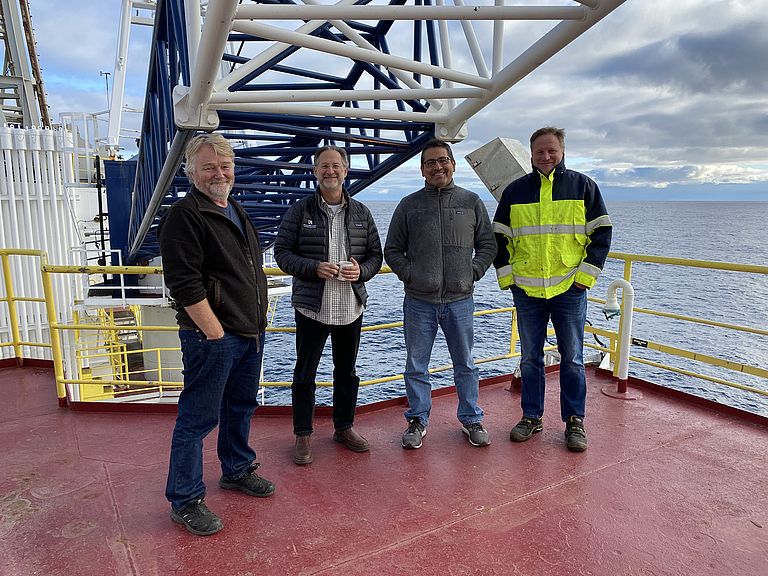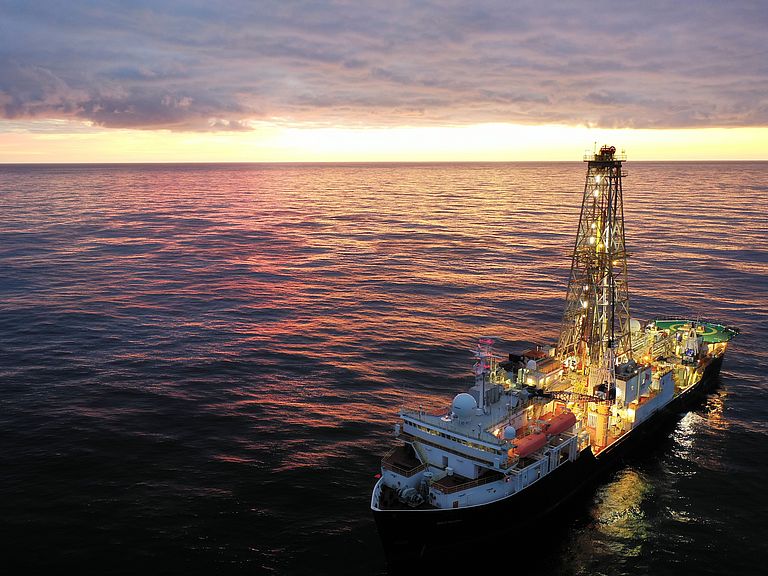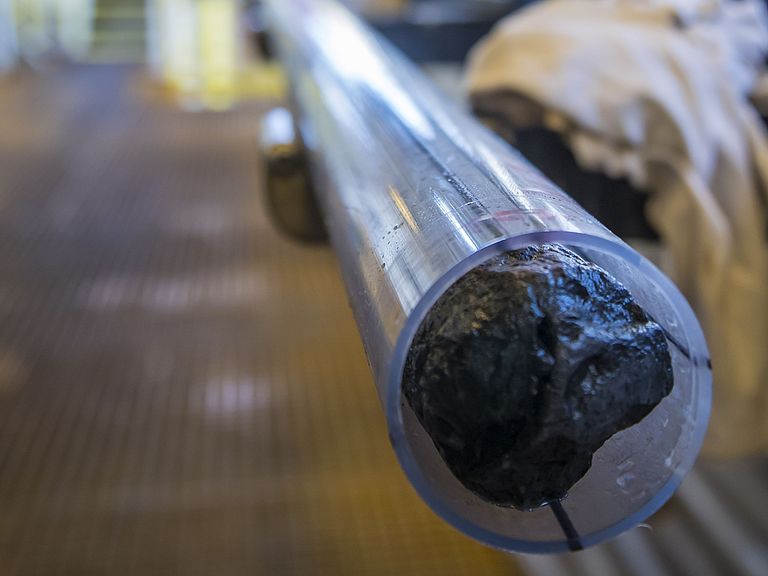Past climate warming driven by hydrothermal vents
New study shows volcanism 56 million years ago released more methane than thought
About 55 million years ago, the Atlantic Ocean was born. Until then, Europe and America were connected. As the continents began to move apart, the Earth’s crust between them ruptured, releasing large volumes of magma. This rift volcanism has led to the formation of large igneous provinces (LIPs) in several places around the world. One such LIP was formed between Greenland and Europe and now lies several kilometres below the ocean surface. An international drilling campaign led by Christian Berndt, Professor of Marine Geophysics at GEOMAR Helmholtz Centre for Ocean Research in Kiel, Germany, and Sverre Planke, Professor of Marine Geophysics at the University of Oslo, Norway, has collected extensive sample material from the LIP, which has now been evaluated.
In their study, published today in the journal Nature Geoscience, the researchers can show that hydrothermal vents were active at very shallow depths or even above sea level, which would have allowed much larger quantities of greenhouse gases to enter the atmosphere than previously thought.
"At the Paleocene-Eocene boundary, some of the most powerful volcanic eruptions in Earth’s history took place over a period of more than a million years," says Christian Berndt. According to current knowledge, this volcanism warmed the world's climate by at least five degrees Celsius and caused a mass extinction - the last dramatic global warming before our time, known as the Paleocene-Eocene Thermal Maximum (PETM). Geologists have not yet been able to explain why, as most modern volcanic eruptions cause cooling by releasing aerosols into the stratosphere.
Further studies of the Karoo large igneous province in South Africa revealed an abundance of hydrothermal vents associated with magmatic intrusions into the sedimentary basin. This observation among others led to the hypothesis that large amounts of the greenhouse gases carbon dioxide and methane could have entered the atmosphere through hydrothermal venting. "When our Norwegian colleagues Henrik Svensen and Sverre Planke published their results in 2004, we would have loved to set off immediately to test the hypothesis by drilling the ancient vent systems around the North Atlantic," says Christian Berndt. But it wasn't that easy: "Our proposal was well received by the Integrated Ocean Drilling Program (IODP), but it was never scheduled because it required riser drilling, a technology that was not available to us at the time."
As the research progressed hydrothermal vent systems were discovered that were within reach of riserless drilling. Thus, the drilling proposal was resubmitted, and the expedition could finally begin in autumn 2021 – 17 years after the first proposal was submitted.
Around 30 scientists from 12 nations took part in the IODP (now the International Ocean Discovery Program) research cruise to the Vøring Plateau off the Norwegian coast on board the scientific drilling ship "JOIDES Resolution". Five of the 20 boreholes were drilled directly into one of the thousands of hydrothermal vents. The cores obtained can be read by scientists like a diary of the Earth's history. The results were compelling.
The authors show that the vent was active just before the Paleocene Eocene Thermal Maximum and that the resulting crater was filled in a very short time, just as the global warming began. Quite unexpectedly, their data also show that the vent was active in a very shallow water depth of probably less than 100 metres. This has far-reaching consequences for the potential impact on the climate. Christian Berndt: "Most of the methane that enters the water column from active deep-sea hydrothermal vents today is quickly converted into carbon dioxide, a much less potent greenhouse gas. Since the vent we studied is located in the middle of the rift valley, where the water depth should be greatest, we assume that other vents were also in shallow water or even above sea level, which would have allowed much larger amounts of greenhouse gases to enter the atmosphere".
As far as today's climate warming is concerned, there are some interesting conclusions to be drawn from the cores. On the one hand, they do not confirm that the global warming at that time was caused by the dissolution og gas hyrates – a danger that has been much discussed in recent years. On the other hand, they show that it took many millennia for the climate to cool down again. So the Earth system was thus able to regulate itself, but not on time scales relevant to today's climate crisis.
Original publication:
Berndt, C., Planke, S., Alvarez Zarikian, C.A. et al. Shallow-water hydrothermal venting linked to the Palaeocene–Eocene Thermal Maximum. Nat. Geosci. (2023). https://doi.org/10.1038/s41561-023-01246-8
About IODP:
The International Ocean Discovery Program (IODP), which funded the research expedition, is an international marine research collaboration that provides scientific drillships to enable scientists to explore the history and dynamics of the Earth by recovering data recorded in seafloor sediments and rocks. IODP depends on facilities funded by three platform providers with financial contributions from five other partner organisations. Together, these organisations represent 21 nations. The long-standing international collaboration began in 1940 and has continued through various phases under different names (the Deep Sea Drilling Project, DSDP, 1968-1983, the Ocean Drilling Program, ODP, 1983-2003, and the Integrated Ocean Drilling Program, IODP, 2003-2013). Today, the IODP partners continue their collaboration under the name International Ocean Discovery Program.

The drilling vessel "JOIDES Resolution" off the Norwegian coast. Photo: Peter Betlem (IODP)

Aboard the JOIDES Resolution: Cruise leader Professor Dr Christian Berndt from the GEOMAR Helmholtz Centre for Ocean Research (left) discusses the drilling process with operations manager Steve Midgley (IODP JRSO). Photo: Sandra Herrmann (IODP/JRSO)

On deck of the JOIDES Resolution: The cruise leaders Professor Dr Sverre Planke from the University of Oslo (left) and Professor Dr Christian Berndt from GEOMAR (right) with the scientists Carlos Alvarez Zarikian from IODP (2nd from right) and Reed Scherer from Northern Illinois University (2nd from left). Photo: Sayantani Chatterjee (IODP)

The drilling ship "JOIDES Resolution" at sunrise. Photo: Peter Betlem (IODP)

A drill core is brought on board the JOIDES Resolution for scientific analysis. Photo: Sandra Herrmann (IODP/JRSO)
![[Translate to English:] Fragments of drill cores of different colouring lie in gullies](/fileadmin/_processed_/8/5/csm_exp396_130_2021-08-29_Bohrkernh%C3%A4lften_Sandra_Herrmann_IODP_JRSO_1977d54cd9.jpg)
Each section of the cores looks different and contains information that experts can read like a diary of the Earth's history. Photo: Sandra Herrmann (IODP/JRSO)


